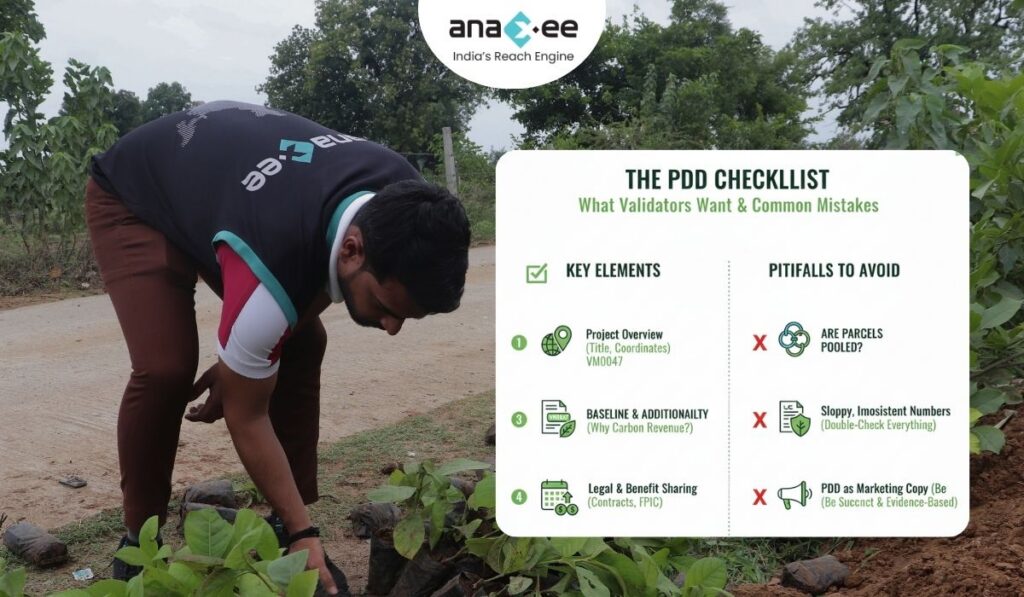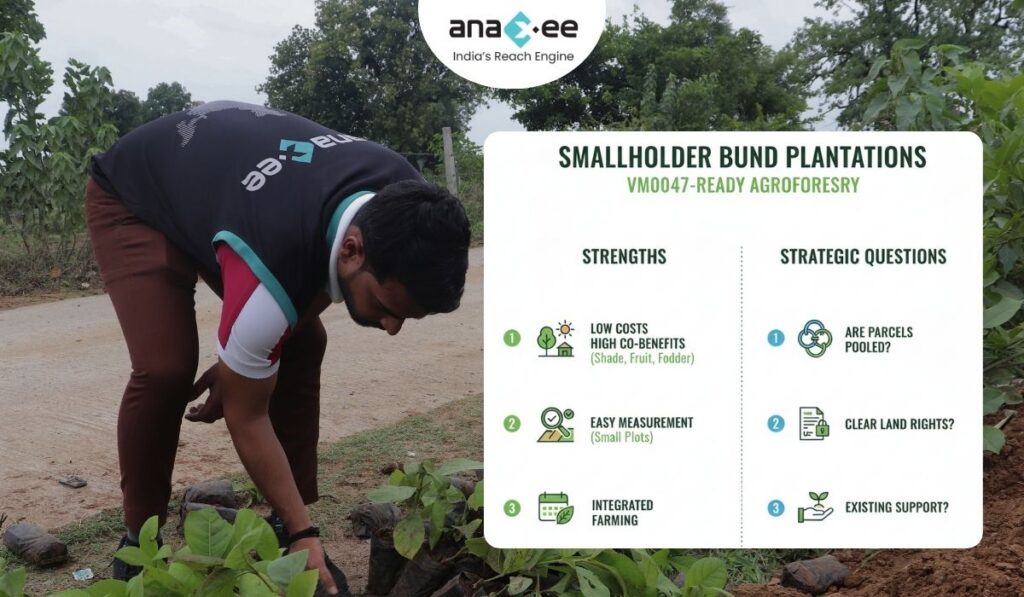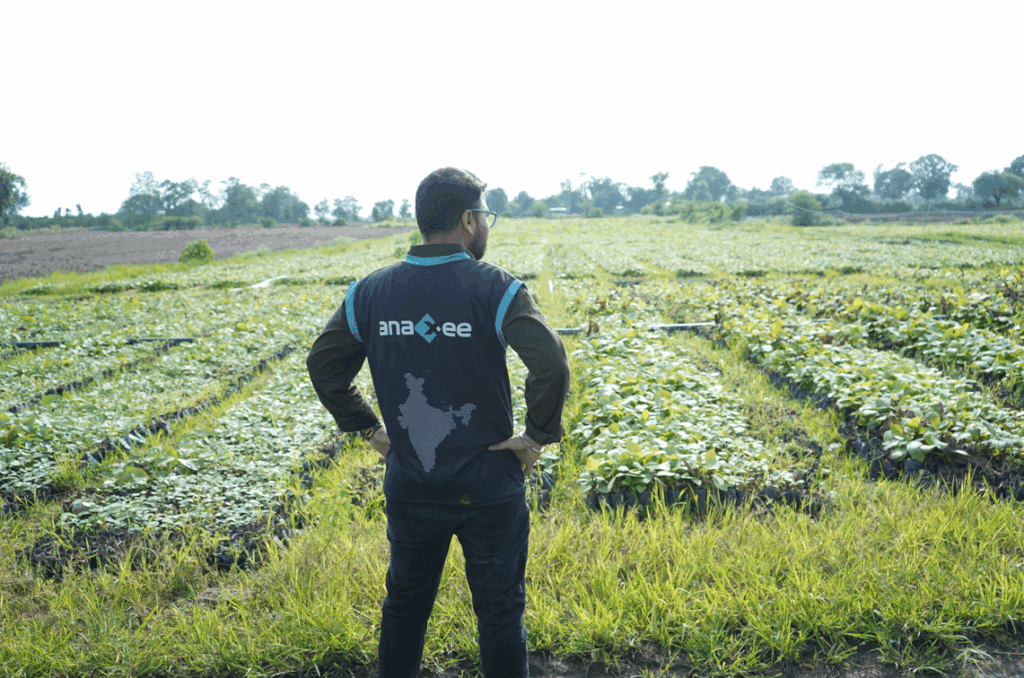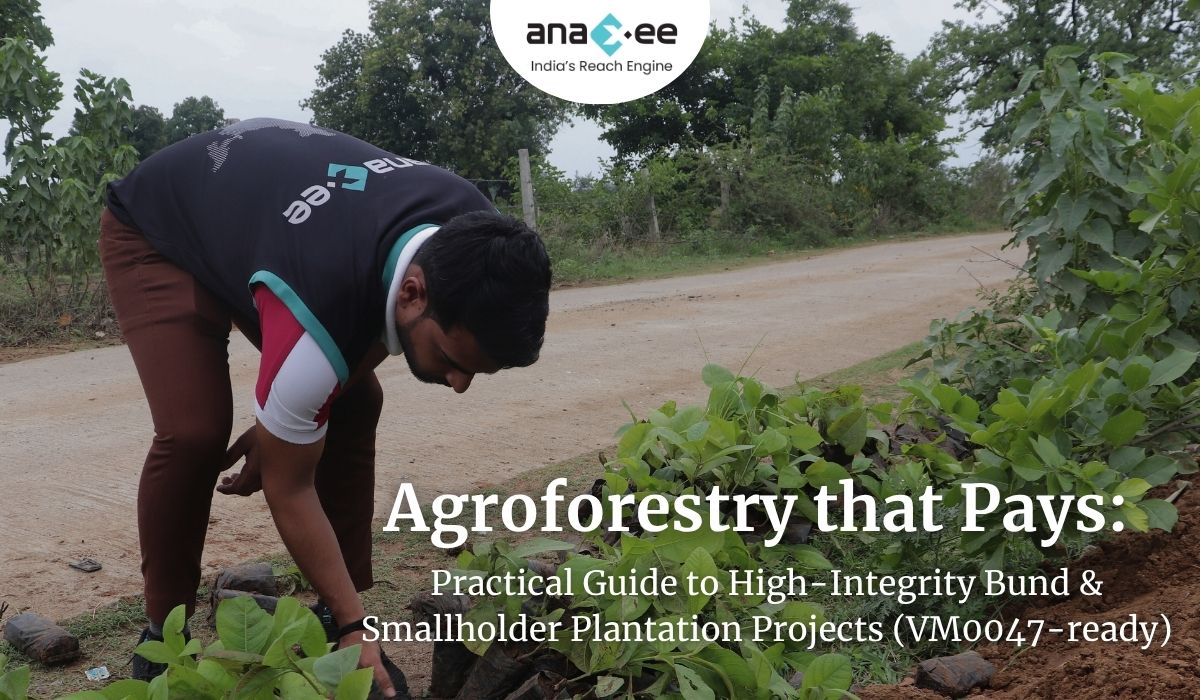Agroforestry that Pays: Practical Guide to High-Integrity Bund & Smallholder Plantation Projects (VM0047-ready)
Agroforestry isn’t a feel-good sidebar to climate policy — it’s one of the few Nature-based Solutions already proven to deliver measurable carbon removals while generating local income and soil resilience. But turning plots into verified carbon credits requires more than tree-planting zeal. The difference between a project that sells quality credits and one that stalls under validation is in the design, documentation, monitoring, and benefit-sharing structure. This is a practical, no-nonsense guide to designing VM0047-style agroforestry projects (including bund plantation models for smallholders), with a focus on how Anaxee’s implementation + MR capabilities translate theory into bankable credits.
1) Start here: pick the right intervention and scale
Agroforestry projects range from alley cropping and boundary planting to large afforestation parcels. For smallholder bund plantations (a common model in South Asia), the practical strengths are:
-Low entry costs and high social co-benefits (shade, fodder, fruit, erosion control).
-Easier parcel-level measurement when plots are small and ownership is clear.
-Clear integration with cropping calendars so farmer livelihoods are not disrupted.
But selection must be strategic. Ask: are parcels contiguous enough to use pooled sampling? Are land rights clear? Is there an existing extension network to deliver seedlings and training? The manual stresses early documentation of land tenure and legal evidence — do not skip this. Land title and carbon-asset ownership will be scrutinized during validation.
2) The PDD checklist: what validators want to see (and what developers routinely get wrong)

Validation bodies and methodologies require precise, consistent documentation. The manual includes a practical PDD checklist — use it as your playbook. Key PDD elements that must be tight:
-Project overview: clear title, coordinates, developers, start date, and crediting period. Ambiguity here invites long review cycles.
-Eligibility & methodology: explicitly cite the chosen standard and justify methodology applicability (e.g., VM0047 for afforestation/reforestation/revegetation approaches). If using VM0047, demonstrate how your planting model maps to methodology definitions.
-Baseline and additionality: provide robust reasoning for why the activity wouldn’t occur in the absence of carbon revenue. For bund plantations on smallholder plots, baseline arguments must consider existing farmer incentives and local extension programmes.
-Leakage & permanence: identify local drivers of deforestation/land conversion and present leakage mitigation (e.g., buffer pools, landscape-level measures). Permanence risks must be quantified and addressed (insurance, buffer credits).
-Legal & benefit sharing: land title evidence, benefit sharing agreements, and FPIC/consultation records are not optional — they’re central to project integrity. Have contracts ready.
Two mistakes I see repeatedly: (1) sloppy, inconsistent numbers across tables/maps (double-check everything), and (2) treating the PDD like marketing copy. Keep it succinct and evidence-based. The manual explicitly recommends concise PDDs with tables/graphics for clarity.
3) Methodology and measurement choices (VM0047 in practical terms)
VM0047 (afforestation, reforestation and revegetation frameworks and similar approaches) is widely used for tree-planting projects because it provides clear rules on baseline setting, growth curves, carbon pools, and monitoring periods. Practical consequences for an Anaxee bund-plantation project:
-Carbon pools to include: Aboveground biomass is the primary pool; depending on methodology, belowground and soil may need treatment or exclusion. Be explicit in your PDD which pools are modelled and why.
-Ex-ante estimates: your model must be defensible — include growth curves, species parameters, and mortality assumptions. The manual highlights ex-ante vs ex-post treatment and warns that ex-ante estimates must be conservative and justified.
-Sampling design: smallholder mosaics typically require stratified sampling and a mix of remote sensing and plot inventories. Design sample sizes to meet verifier confidence levels — don’t downsize to save costs and then fail verification. The manual recommends combining field plots with remote sensing where possible.
4) Implementation: the operational reality (planting, survival, costs)
Planting is where theory meets human behaviour. Bund plantations need simple, farmer-friendly protocols:
-Species selection: prefer natives or locally proven fast-growing agroforestry species that deliver both carbon and livelihood benefits (fruit, fodder, fuelwood) — this helps uptake and survival.
-Nursery & seedling logistics: centralize seedling production to ensure quality and uniformity. Stagger planting windows to match monsoons and cropping cycles.
-Survival and maintenance: establish a 2–3 year maintenance plan with scheduled visits, fertilization (if applicable), and pest control. Mortality assumptions in the PDD must reflect on-ground survival plans.
-Costs and payment schedules: link farmer incentives to milestones (e.g., survival checks at 6, 12, 24 months). Upfront seedling provision with partial co-funding from farmers can reduce moral hazard but be designed sensitively.
Operational discipline reduces non-permanence risk, lowers verification disputes, and makes credits marketable.
5) Monitoring & MRV that survives scrutiny
Monitoring separates credible projects from wishful thinking. The manual gives practical guidance on what monitoring plans must contain: indicators, data sources, frequency, and protocols. Treat the monitoring plan as the operational manual for your VVB and auditor.
Core MRV components for bund/smallholder agroforestry:
-Carbon indicators: tree survival, DBH/height measurements (or appropriate proxies), species identification.
-Non-carbon indicators: land use change, crop yields, livelihood impacts, SDG co-benefits (useful for buyers who want co-benefit claims).
-Data sources: field plots (stratified), farmer logs, mobile data collection, and satellite imagery for change detection and leakage monitoring. The manual strongly recommends local partner training and simple digital collection tools to scale monitoring while controlling costs.
-Monitoring frequency: at minimum annual carbon monitoring for the first verification cycles; more frequent socio-economic monitoring is recommended in the early years. The manual’s PDD checklist flags the need for a monitoring protocol describing how data will be collected and analysed.
Practical MRV tips (Anaxee’s edge):
-Use mobile forms and GPS-tagged photos at each plot visit to make audits painless.
-Store raw data and derived metrics in a consistent directory structure and maintain a change log — verifiers hate ‘missing original data’. The manual stresses documenting all data sources and assumptions.
6) Social safeguards & benefit sharing — not a checkbox exercise
Carbon projects get audited for social safeguards now as rigorously as for carbon numbers. The manual lays out expected ESG materials: evidence of consultations, FPIC where applicable, gender inclusion, expected livelihood impacts, grievance redress mechanisms, and detailed benefit-sharing plans. These are required elements for registration and market acceptance.
A few hard truths:
-sharing needs simplicity: complicated formulas bury the true winners and frustrate communities. Flat rates tied to milestones or a clear split of monetized credit revenues are easier to administer and verify.
-FPIC & consultation records: keep minutes, sign-offs, and clear communication materials in local language. Document the process; photos and attendance lists help.
-Grievance redress: a named local contact and response timelines are minimum requirements. Auditors will probe whether the mechanism works in practice.
7) Commercialization: who buys these credits and at what price?
Nature-based credits are facing higher scrutiny; buyers want quality, traceability, and co-benefits. The manual’s commercialisation section highlights two practical points: sellers must do due diligence on buyers and price expectations must cover real project costs (including verification and buffer).
Market reality for smallholder agroforestry credits:
-Quality premium: well-documented projects with credible MRV and social safeguards command a premium.
-Blue vs green demand: buyers seeking removals and nature co-benefits prefer projects that demonstrate durable sequestration and strong social outcomes.
-Transaction costs: smaller projects face proportionally higher transaction costs — consider aggregation models (pooled projects under one PDD) to spread VVB and verification costs. The manual references pooling and mosaic approaches used in other NbS contexts.
8) Pitfalls and how to avoid them (real world)

I’ll be blunt: many agroforestry carbon projects fail verification on preventable grounds. Here’s what trips teams up and how to address it:
-Inconsistent documentation: numbers in the PDD, monitoring spreadsheets, and maps must match. Fix: a single source of truth (master spreadsheet + version control). The manual explicitly warns to “be consistent”.
-Under-budgeting verification & VVBs: VVB availability is constrained; engage early and build relationships. The manual suggests securing a VVB early in development.
-Weak local buy-in: if farmers see no short-term benefit, survival suffers. Fix: tie incentives to outcomes and offer clear livelihood co-benefits (fodder, fruit).
-Land tenure ambiguity: unresolved title disputes can derail validation. Fix: obtain documented evidence of land use rights or formal agreements.
9) Scaling strategy: aggregation, registries and programme design
If your ambition is scale, plan for aggregation from day one. The manual highlights landscape/mosaic approaches and suggests programmatic registration options where applicable. Aggregation reduces per-credit transaction costs and improves marketability, but requires rigorous governance (who signs sales contracts; how are revenues pooled?).
Practical structure for scaling:
Standardized PDD template for all clusters.
Centralized MRV hub (data cleaning, sampling oversight).
Local field teams trained as Anaxee’s Digital Runners to collect evidence and resolve issues.
Transparent benefit sharing rules embedded in project documents.
10) Why Anaxee’s implementation + MR strengths matter (short, candid assessment)
You asked me to be frank. Here are where an implementation/MR firm like Anaxee can actually change outcomes — or fail to, if poorly executed:
-Get the PDD right: Anaxee’s field footprint and experience with smallholder engagement reduce practical PDD failure modes (consistency, data quality). The manual stresses local engagement and documentation as credibility drivers.
-dMRV & local teams: training local enumerators and using mobile collection reduces verification time and cost. The manual recommends partnering with local institutions and training communities for monitoring.
-Commercial acumen: many NGOs can plant trees; fewer can package IP and MRV into sellable, audited credits. The manual’s commercialization checklist is a useful reference for negotiating buyer terms and conducting due diligence on buyers.
If Anaxee wants to lead, focus on: standardising PDD templates, building modular MRV stacks, creating clear farmer contracts, and developing a transparent accounting dashboard for buyers.
11) Tools & templates I recommend you publish (and use)
From the manual’s practical orientation, these are the templates that speed validation and increase buyer confidence:
-PDD checklist tailored to bund plantations (land title, sampling, survival assumptions).
-Monitoring protocol template (indicators, QA/QC steps, sampling frames).
-Benefit sharing agreement template (clear revenue split, grievance redress).
-VVB engagement checklist (language & regional capacity, cost expectations).
Publishing these (or portions) on Anaxee’s site as downloadable resources will help buyers and partners assess project maturity quickly.
12) Closing: a reality check for buyers & developers
If you’re a corporate buyer: insist on seeing the monitoring protocol, benefit-sharing agreements, and proof of land rights before committing. Don’t buy on glossy images alone.
If you’re a developer: never let fundraising timelines compress the validation process — rushed projects create stranded credits and reputational loss.
The Eastern-Africa manual we used as a reference is pragmatic: it shows the pathway from concept to commercialization and calls out the non-negotiables — legal proof, robust monitoring, conservative ex-ante estimates, and clear benefit sharing. Treat those as minimum viable ingredients; everything else is optional.
Want a PDD template or dMRV checklist tailored to your bund project? Contact Anaxee’s Implementation Team at sales@anaxee.com



